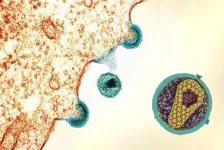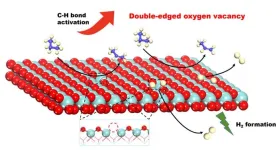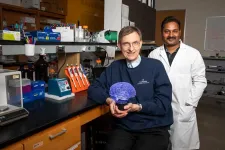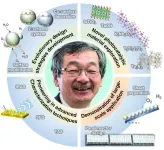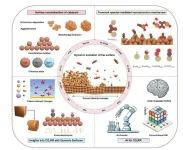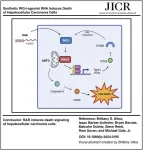(Press-News.org) PHILADELPHIA – Cancer patients spend a lot of time on their care. Meeting with doctors and other members of their health care team, getting labs and other tests, picking up prescriptions, and undergoing treatment all takes time. So does getting to and from each appointment, sitting in the waiting room between each appointment, and so on.
In recent years, cancer researchers have worked to quantify the level of “time toxicity” or time spent commuting to, waiting for, and receiving cancer treatment. Now, for the first time, a pilot study has shown it’s possible to use digital technology to safely reduce the amount of time some patients spend receiving care. With a simple text-messaging system, patients saved more than an hour at each visit captured by the study, which was led by researchers from the Perelman School of Medicine at the University of Pennsylvania and Penn Medicine’s Abramson Cancer Center, and published in NEJM Catalyst today.
“Patients with cancer spend an enormous amount of time engaging with the health care system, and for patients with advanced cancer in particular, that time is precious,” said senior author Ronac Mamtani, MD, section chief of Genitourinary Cancers. “We developed a safe and effective platform that—for certain patients—could really challenge the status quo and give them quality time back.”
A fast-track system
Inspired by the efficiency of the TSA pre-check line to bypass long lines at the airport, Mamtani and former Penn oncology fellow and lead author Erin M. Bange, MD, MSCE, now an assistant professor at Memorial Sloan Kettering Cancer Center, developed a text message-based platform using the Center for Health Care Transformation and Innovation’s Way to Health platform to obtain patient reported-symptoms and make sure patients are ready for immunotherapy treatment. Patients receiving immunotherapy for cancer treatment are currently required to complete bloodwork and meet with their health care team in the office before every infusion to confirm they have not developed any concerning symptoms that might signal a reaction to the immunotherapy and a need to pause treatment. The pre-treatment symptom check is a necessary safety measure that many patients treated with immunotherapy pass with flying colors, given the relatively low rate of side effects for immunotherapy compared to traditional chemotherapy.
In this pilot clinical trial, patients receiving single-agent immunotherapy for solid tumor cancers at Penn Medicine’s Abramson Cancer Center were enrolled and randomized to either an in-person pre-infusion symptom check in the office with their provider, or to complete a 16-question symptom check, estimated to take less than five minutes, via the text message platform. If their labs were normal and no symptoms were reported, patients were given the option to fast-track and bypass the in-person visit, proceeding directly to their immunotherapy infusion. The 16 patients who were fast-tracked saved more than 60 minutes per visit, including 30 minutes less wait time, than the 15 patients who were randomized to continue with the usual in-person visit.
More importantly, the fast-track system was safe, with no difference in post-infusion hospital visits or health-related quality of life impact compared to usual care.
“Considering that patients who consented for the study told us that saving even 45 minutes per visit would significantly impact their lives, we were excited to see that our first test of this tool surpassed expectations, giving patients even more time back each time they went in for treatment,” Bange said.
While patient-reported outcomes have been used in other studies to assess various quality of life measures, the authors note that this study is the first time digital patient-reported outcomes have been used to streamline cancer care delivery.
Limitations and next steps
A total of 19 additional patients who reported their symptoms via the text message platform were eligible for fast-track, but ended up continuing with the in-person visit instead, due to patient preference, provider preference, or other care coordination issues. The study team emphasized that some patients may prefer to continue in-person visits, and the team’s vision for the text message platform is to be an option for patients who want to use it, rather than a one-size-fits-all approach.
The team also conducted focus groups with health care providers to better understand any concerns about the fast-track process and potential barriers to broader implementation.
“Our goal is to ultimately test this strategy in a pragmatic trial, where it’s used in a real-world setting and not the controlled setting of a traditional clinical trial, but we want to be sure that we have the best-designed tool to effectively meet both provider and patient needs, so we’re taking time to assess the feedback and refine our approach before moving forward,” Mamtani said. “Cancer patients are repeatedly asked to hurry up and wait while getting care. What we’re trying to address is just the tip of the iceberg in terms of giving patients valuable time back to focus on living.”
The study was supported by an ASCO Conquer Cancer Young Investigator Award, Marjorie and Bryan Weingarten Fellowship Grant, the Health Network Foundation, and the National Institutes of Health/National Cancer Institute (P30CA016520).
###
Penn Medicine is one of the world’s leading academic medical centers, dedicated to the related missions of medical education, biomedical research, excellence in patient care, and community service. The organization consists of the University of Pennsylvania Health System and Penn’s Raymond and Ruth Perelman School of Medicine, founded in 1765 as the nation’s first medical school.
The Perelman School of Medicine is consistently among the nation's top recipients of funding from the National Institutes of Health, with $550 million awarded in the 2022 fiscal year. Home to a proud history of “firsts” in medicine, Penn Medicine teams have pioneered discoveries and innovations that have shaped modern medicine, including recent breakthroughs such as CAR T cell therapy for cancer and the mRNA technology used in COVID-19 vaccines.
The University of Pennsylvania Health System’s patient care facilities stretch from the Susquehanna River in Pennsylvania to the New Jersey shore. These include the Hospital of the University of Pennsylvania, Penn Presbyterian Medical Center, Chester County Hospital, Lancaster General Health, Penn Medicine Princeton Health, and Pennsylvania Hospital—the nation’s first hospital, founded in 1751. Additional facilities and enterprises include Good Shepherd Penn Partners, Penn Medicine at Home, Lancaster Behavioral Health Hospital, and Princeton House Behavioral Health, among others.
Penn Medicine is an $11.1 billion enterprise powered by more than 49,000 talented faculty and staff.
END
Text message tool addresses “time toxicity” for cancer patients
In pilot study, patients saved over an hour of time at every treatment visit
2025-02-19
ELSE PRESS RELEASES FROM THIS DATE:
New therapy may effectively control HIV in Uganda
2025-02-19
A multi-national, multi-institutional study led by Weill Cornell Medicine investigators found little natural resistance to a new HIV therapy called lenacapavir in a population of patients in Uganda.
The study, published Jan. 30 in the Journal of Antimicrobial Chemotherapy, adds to growing evidence that lenacapavir may be a powerful new tool in the global anti-HIV drug arsenal. Approximately, 1.5 million people are living with HIV in Uganda.
“Our data shows that only 1.6% of the individuals studied are living with HIV ...
Global retreat of glaciers has strongly accelerated
2025-02-19
There are currently around 275,000 glaciers worldwide, in which huge quantities of fresh water are stored. But this reservoir is increasingly shrinking. Since the turn of the millennium, glaciers around the world – i.e. ice masses on land excluding the Greenland and Antarctic ice sheets – have lost around 273 billion tonnes of ice per year. This corresponds to about five and a half times the volume of Lake Constance. Overall, the world’s glaciers have lost around five per cent of their total volume since the year 2000. This is the conclusion reached by an international research team of which Tobias Bolch from the Institute of Geodesy ...
Data from all 50 states shows early onset breast cancer is on the rise in younger women: Does place of exposure matter?
2025-02-19
February 19, 2025-- Breast cancer incidence trends in U.S. women under 40 vary by geography and supports incorporating location information with established risk factors into risk prediction, improving the ability to identify groups of younger women at higher risk for early-onset breast cancer, according to a new study at Columbia University Mailman School of Public Health. This study comprehensively examined trends across different states, regions, metropolitan versus non-metropolitan areas and by racial and ethnic groups. It also is one of the first to incorporate ...
California prison resentencing project yields modest results
2025-02-19
A three-year effort to encourage California prosecutors to reconsider the sentences given to some people in state prison has resulted in a modest number of people being resentenced, but improvements are needed to speed review of more cases, according to a new RAND report.
During the project involving nine counties, more than 1,100 cases received an initial review. After comprehensive reviews by county district attorneys for the suitability for resentencing, 227 individuals eventually received new sentences and 174 of those offenders had been released ...
Revealing the double-edged role of oxygen vacancy on ZrO2 catalysts in propane dehydrogenation
2025-02-19
Propane dehydrogenation (PDH), as an efficient catalytic production process to obtain propylene, has developed rapidly in recent years. Previous studies have shown that zirconia exhibited excellent performance in the PDH, with the coordination-unsaturated zirconium (Zrcus) around the oxygen vacancy being the active site in the reaction. However, the critical role of oxygen vacancy is still remaining elusive, and lacked a rationale to establish a relation between structure and performance. Moreover, the strong binding of propene and hydrogen molecules shadowed ...
Mutation increases enzyme in mouse brains linked to schizophrenia behaviors
2025-02-19
CHAMPAIGN, Ill. — A genetic mutation found in two human patients with schizophrenia also increased schizophrenia-related behaviors in mice with the same mutation, a rare finding of a direct genetic link to psychosis, report researchers at the University of Illinois Urbana-Champaign and colleagues in Massachusetts and Germany.
The mutation increases levels of glycine decarboxylase, or GLDC, an enzyme responsible for regulating glycine in the brain. Glycine activates receptors for the neurotransmitter glutamate, called NDMA receptors.
“The genetics of schizophrenia is very complex, and it ...
We can farm more seafood while minimizing its impact on biodiversity, U-M research shows
2025-02-19
Humanity can farm more food from the seas to help feed the planet while shrinking mariculture's negative impacts on biodiversity, according to new research led by the University of Michigan.
There is a catch, though: We need to be strategic about it.
"We can achieve this sustainable mariculture development," said Deqiang Ma, who led the study as a postdoctoral researcher at the U-M School for Environment and Sustainability. "With strategic planning, we can achieve the goal of conserving marine species while meeting the global demand for the ...
Professor Kazunari Domen: Groundbreaking contributions to photocatalytic water splitting
2025-02-19
Harnessing solar energy to produce hydrogen from water – the photocatalytic water splitting reaction, is a promising approach for the carbon-neutrality future. This process utilizes semiconductor materials to harvest sunlight for the splitting of water into hydrogen fuel with oxygen gas generated as by-product. The solar hydrogen, as a carbon-free energy source, holds immense potential for decarbonizing industries, addressing global energy demands and mitigating environmental challenges. However, realizing practical ...
Electrochemical carbon dioxide reduction: Dynamic surfaces of Cu-based catalysts
2025-02-19
The continued massive consumption of fossil fuels in modern societies has led to a range of environmental issues, including excessive CO2 emissions. In this regard, electrochemical CO2 reduction can convert intermittent electricity into chemical fuels and other value-added products, which holds the potential to close the carbon cycle. Among the various catalysts, metals are the most extensively studied heterogeneous CO2RR electrocatalysts and can be classified into three categories based on the main products. Containing Bi, ...
Synthetic RIG-I-agonist RNA induces death of hepatocellular carcinoma cells
2025-02-19
New Rochelle, NY, February 19, 2025—A new study in the peer-reviewed Journal of Interferon & Cytokine Research (JICR) showed that a specific retinoic acid-inducible gene I (RIG-I) agonist RNA (RAR) induces innate immune signaling and death of hepatocellular carcinoma cells in vitro. Click here to read the article now.
Michael Gale, Jr., from the University of Washington School of Medicine, and coauthors, evaluated the actions of a specific RIG-I agonist RNA against two distinct human hepatocellular carcinoma cell lines. RAR is a synthetic-modified ...
LAST 30 PRESS RELEASES:
University of Oklahoma researcher awarded funding to pursue AI-powered material design
Exploring how the visual system recovers following injury
Support for parents with infants at pediatric check-ups leads to better reading and math skills in elementary school
Kids’ behavioral health is a growing share of family health costs
Day & night: Cancer disrupts the brain’s natural rhythm
COVID-19 vaccination significantly reduces risk to pregnant women and baby
The role of vaccination in maternal and perinatal outcomes associated with COVID-19 in pregnancy
Mayo Clinic smartwatch system helps parents shorten and defuse children's severe tantrums early
Behavioral health spending spikes to 40% of all children’s health expenditures, nearly doubling in a decade
Digital cognitive behavioral treatment for generalized anxiety disorder
Expenditures for pediatric behavioral health care over time and estimated family financial burden
Air conditioning in nursing homes and mortality during extreme heat
The Alps to lose a record number of glaciers in the next decade
What makes a good proton conductor?
New science reporting guide published for journalists in Bulgaria
New international study reveals major survival gaps among children with cancer
New science reporting guide published for journalists in Turkey
Scientists develop a smarter mRNA therapy that knows which cells to target
Neuroanatomy-informed brain–machine hybrid intelligence for robust acoustic target detection
Eight SwRI hydrogen projects funded by ENERGYWERX
The Lundquist Institute and its start-up company Vitalex Biosciences Announces Strategic Advancement of Second-Generation fungal Vaccine VXV-01 through Phase 1 Trials under $40 Million Competitive Con
Fine particles in pollution are associated with early signs of autoimmune disease
Review article | Towards a Global Ground-Based Earth Observatory (GGBEO): Leveraging existing systems and networks
Penn and UMich create world’s smallest programmable, autonomous robots
Cleveland researchers launch first major study to address ‘hidden performance killer’ in athletes
To connect across politics, try saying what you oppose
Modulating key interaction prevents virus from entering cells
Project explores barriers to NHS career progression facing international medical graduates
Jeonbuk National University researchers explore the impact of different seasonings on the flavor perception of Doenjang soup
Two Keck Medicine of USC Hospitals named Leapfrog Top Teaching Hospitals
[Press-News.org] Text message tool addresses “time toxicity” for cancer patientsIn pilot study, patients saved over an hour of time at every treatment visit
